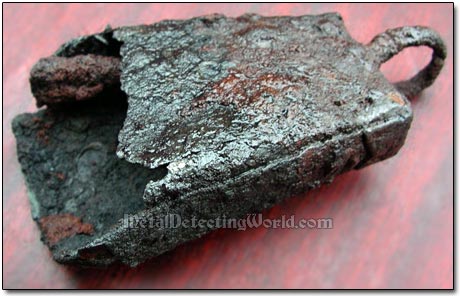Rust Removal with Electrolysis - A Detailed Illustrated Tutorial, page 7
1. Introduction: Is Electrolysis Always Practical?
Not so in 1% of all cases of rusted artifacts. As it was stated above, the electrolysis can clean any iron/cast iron/plain steel objects of any size. If you have to de-rust a large part, but do not have a plastic container that is large enough for the part to fit in, you can de-rust one half of your part/artifact at a time. I call it "two-session electrolysis". There would not be any lap marks on the artifact if you electrolyze it a little longer than necessary. This tutorial covers the "two-session electrolysis".
So, the issue of this method's practicality is not about the size of an artifact to be de-rusted. It is about the amount of "live" iron metal preserved inside the artifact prior to de-rusting. In other words, if most of the artifact's iron metal has been converted into rust over years, and now electrolysis removes it, there will be a little piece of artefact left - you would not even recognize it!
When I started using the electrolysis method, I made a bad mistake by subjecting a medieval canister sheep bell to the electrolytic de-rusting. The bell was made out of thin sheet iron and, after having been in mineralized soil for 400 years, was enwrapped by rust which had reduced the sheet iron to the thinnest layer.
And, of course, it was too late for me to rescue the bell from the electrolyte when I noticed that the bell's half was fast disappearing along with the rust! It was good that I started de-rusting just a first half of this bell, at least the other half remained in one piece. In this case, using electrolysis was very unpractical. To preserve the medieval sheep bell, I should put it into the Fish Oil or Coca-Cola bath for a month or longer.

Lower Half of My Canister Sheep Bell Almost Disappeared Along with Rust during Electrolysis
NOTE: The amount of mechanical action - cleaning with wire- or nylon brushes, will also depend on the fragility of the object. Use your discretion.
Some iron objects can be very awkward to clean. To clean the object's inner space or cavity, you can insert or suspend an anode inside the object. To clean just a few spots on a large object, or around the parts, such as wood handles, that should not be submerged in electrolyte, you can soak a sponge in the electrolyte, and attach an anode to it. When abrasive blasting is unavoidable, the electrolytic pre-treatment cuts cleaning time enormously.
All paints will be easily removed by electrolysis. Strong metal plating will not be affected by electrolytic cleaning unless there is rust underneath it, then a metal coating will be lifted. The electrolyte can soften a thin coat of metal plating. A test with a drop of electrolyte onto an unnoticeable spot on the object should be performed. All nonmetallic parts should be removed from the iron object, if possible, before electrolytic cleaning.
CONCLUSION:
Electrolysis is the most practical way to remove rust from the iron artifacts and objects; however, the electrolytic de-rusting might be not very practical in two cases: 1) de-rusting of the thin sheet iron parts, and 2) derusting the areas that are closed off to the current which cannot develop a large field of voltage. Care and wisdom must be applied for valuable, archeological, historical, mechanical, or structural iron objects.